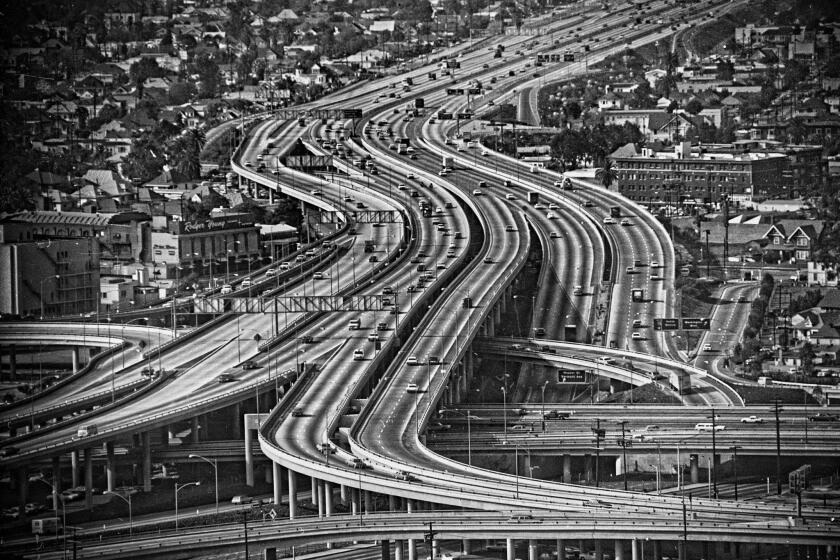Review: Walking with the dead in Robert Macfarlane’s earthy, beautiful “Ghostways”
On the Shelf
Ghostways: Two Journeys in Unquiet Places
By Robert Macfarlane
Norton: 144 pages, $16
If you buy books linked on our site, The Times may earn a commission from Bookshop.org, whose fees support independent bookstores.
Robert Macfarlane has been down this road before. Since the publication of his first book, “Mountains of the Mind,” in 2003, he has traced the ways in which people don’t so much remake nature as we are, collectively and individually, remade by it. “Paths,” he tells us in “The Old Ways” (2012), “are the habits of a landscape. They are acts of consensual making. It’s hard to create a footpath on your own.” This is terrain as dynamic, shaped across generations by the living and the dead. “The Old Ways” is my favorite of Macfarlane’s works, not least because it is about walking: “This book,” he writes, “could not have been written by sitting still.”
Something similar might be said of “Ghostways,” which gathers a pair of short illustrated essays, “Ness” and “Holloway” — collaborations with artist Stanley Donwood originally published in Great Britain as small standalone volumes but never before available in the United States. Contemplative, impressionistic and suffused with aspects of the mythic, these pieces operate at times like prose poems, and they return to a key setting of “The Old Ways”: the secret spaces of southern England, the flashpoints and the hidden paths.
Macfarlane walks for the same reason I do: to be connected. To the landscape, yes, but also to its history. Every walk, urban or rural, follows in the footsteps of those who have trod these paths before. For Macfarlane, this adds weight to the places he writes about, allowing his observations to extend beyond personal experience and into the realms of ethnography and art.
In “Alta California,” Nick Neely walks 650 miles along El Camino Real to explore “where we actually live.”
“Ness,” for instance, is set in the Orford Ness, a slender spit of land on the Suffolk coast that “[f]or seventy years … was used by the British Ministry of Defence to conduct secret weapons tests.” “Holloway” investigates “a deep-sunk lane in Dorset … a ‘hollowed way’ used by walkers and riders for so many centuries that it has become worn far down into the soft golden bedrock of the region.” Together, they offer not a guide so much as a set of glimpses, enhanced by Donwood’s vivid sketches, which resemble etchings in a fairy tale.
For Macfarlane, place interacts with us. Or better yet: It evolves. “Listen again,” he insists early in “Ness,” the longer piece that opens “Ghostways.” “Listen to the pasts of Ness. Listen inland to the long-gone wood. … Listen to the wrench of the door in the Centrifuge Dome. Listen to the rise of the still encroaching ocean. … Listen to the rumoured motion of the rumoured bodies on the rumoured shore.” At heart here is a sense of inference, or influence; the way the present is imbued with the past.
Although “Ness” is less a narrative of walking than “Holloway,” both works operate from the heightened observation of the foot traveler. Walking is a passage through both place and history. “In 1689,” the author reflects, “the Japanese poet Basho followed his narrow path to the far north, & as he walked he spoke often with the long-dead poets of the past, including his twelfth-century forebear Saigyo, such that he came afterwards to describe his travels as conversations between a ghost and a ghost-to-be.”
A ghost and a ghost-to-be? Any dedicated walker knows exactly what he means. To walk a worn path is to travel with the dead. Macfarlane makes the idea explicit in “Holloway,” which involves two visits to the same landscape — the first in 2004 with his friend Roger Deakin, the second with Donwood and Dan Richards after Deakin’s death.
The journeys are constructed to echo one another; in each, the voyagers carry “a hipflask, two penknives, matches & candles,” as well as a copy of Geoffrey Household’s 1939 thriller “Rogue Male.” In that novel, a British hunter is run to ground by foreign agents after he tries to kill a dictator modeled on Adolf Hitler; he takes refuge in a Dorset hollow. The book “was our guide to the holloway’s location,” Macfarlane confides. Yet once he and his companions arrive, they discover that the novelist’s directions were encrypted; “the landscape of the novel would not quite fit the landscape itself.” It’s a stunning metaphor, reminding us of the elusive interplay between what we envision (or remember) and what we see.
In travel writer Richard Grant’s “The Deepest South of All,” Natchez, Miss., is full of characters, stubborn racist traditions and lots of contradictions.
Such a balance is essential to Macfarlane’s conception of the path as ghostway, in which not knowing is essential to the experience. Whatever connection we might feel to those who walked before us, we can only surmise who they were and how they may have lived. That’s part of the appeal of walking but also its limitation: It offers proximity, but only so much. Like everyone, we remain bound up in time. “The holloway is absence,” Macfarlane explains; “a wood-way worn away by buried feet. … Walking, running, hiding man, huddled in the lee of a tree.”
That huddled man may represent the protagonist of “Rogue Male,” but so too is he Macfarlane and his friends. In “Ghostways,” they look back and forth across the decades at one another, as if through a hagstone — “a flint pebble,” the author explains, “with a hole worn naturally through it. In folklore across Europe, to look through such a stone is to see into the future, the past or the afterlife.” Throughout “Ness,” Macfarlane returns to the stone as a motif, a lens.
“Ness is a place to improvise,” he writes. “Ness is its own realm with its own rules.” Crossing over to the spit is like crossing the River Styx: “Two flints on your eyes for the journey, cold on the lids, keeping sight in so you couldn’t find your way back.” It’s a landscape, much like the holloway in Dorset, in which to be found we must first surrender and be lost. Drift, Macfarlane calls this, as in: “Drift is always becoming. Drift has unbounded potential. … Drift happens to you rather than you to Drift.” This is, of course, the central faith and tenet of the walker, which is that the narrative emerges from the walk.
“Ghostways” is a strangely lovely book, more complement than extension of Macfarlane’s work. But in their modesty, their open-endedness, these peregrinations recall to us that even the newest ground is also ancient. The landscapes here may be remote, but they “run through people as surely as they run through places.” They tell us, in other words — as landscapes always do — who and where we are.
UCLA design professor Peter Lunenfeld’s “City at the Edge of Forever: Los Angeles Reimagined” has inspiring passages and others that miss the mark.
Ulin is the former book editor and book critic of the Times.
More to Read
Sign up for our Book Club newsletter
Get the latest news, events and more from the Los Angeles Times Book Club, and help us get L.A. reading and talking.
You may occasionally receive promotional content from the Los Angeles Times.











